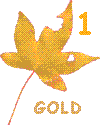 NAME: Beatrice Laporte
NAME: Beatrice LaporteLOCATION: Merrickville, Ontario, CANADA
AWARD DATE: March 21, 2011

 NAME: Beatrice Laporte
NAME: Beatrice Laporte
- Osprey Pandion haliaetus
- Canada Geese Branta canadensis
- Cedar Waxwing Bombycilla cedrorum
- Ruby Throated Hummingbird Archilochus colubris
- American Goldfinch Carduelis tristis
- Ring-billed Gull Larus delawarensis
- Blue Jay Cyanocitta cristata
- Mourning Dove Zenaida macroura
- European Starling Sturnus vulgaris
The Blanding’s Turtle was my best find because this
species of turtle is a “species at risk” here in Ontario and is considered to be
endangered or threatened throughout its range. Habitat fragmentation and destruction as
well as the fact that it can take them up to 25 years to be able to reproduce, are a few
of the difficulties this turtle faces. I feel very fortunate to have crossed paths with
one. For more information on the Blanding’s Turtle you can go to Nature
Canada’s website and read their profile, which also features my picture.
Photographing butterflies and moths has now become my passion! Last summer I kept seeing Red
Admiral butterflies fluttering around my home, but every time I tried to get
close with my camera, I would get within three feet and they would fly away. And often as
I was walking away in frustration, another one of these pretty butterflies would fly close
by, like it was teasing me, and I was off again. After about two weeks of unfruitful
attempts there came a day that I was determined to make that the day I would finally get a
picture. I began working on my yard, gathering branches and sticks off my lawn and putting
them into our fire pit, and that’s when I spotted the next Red Admiral which after
fluttering by decided to land right on my chest, right there beneath my nose! There
wasn’t a thing I could do with my camera around my waist and my hands full, so all I
did was take a good, close look. But later that day, one of these pretty butterflies took
pity on me and allowed me to have a photo session with it.
Photographing a Snowshoe Hare was quite exciting because I would often
flush them out when I was walking through the woods, and I didn’t even know they were
there until they made that dash to safety, stomping their feet loudly as they raced away,
so catching a shot of one seemed almost impossible. Until I came upon one who seemed as
curious of me as I was of him, so he paused long enough for me to snap a picture before he
darted away like all the others.
Spiders are something that I never really paid much attention to, until I
started photographing them. That’s when I discovered their eight eyes, hairy bodies
and fangs kind-of creeped me out and that I actually had a little bit of arachnophobia. At
the same time these little creatures fascinated me, seemingly as aware and frightened of
me as I was aware and wary of them. I also discovered that spiders can actually have very
beautiful patterns.
One fine day in June a friend of mine took me to see some Moccasin Flowers
(or Pink Lady's Slippers) that grew on the forest floor in a conservation area not far
from where I live. They grew under White Pine trees, spread across large areas, so many of
them in some places that you needed to watch where you were putting your feet while
photographing them. What a feeling to behold these beautiful pink jewels of the forest
floor that I didn’t even know were there until a thoughtful friend brought me to see
them to share in their wonder.
I’ve learned that the diversity of organisms just in my own backyard
is absolutely incredible! It never ceases to amaze me to think that we all had the same
beginning; that we all evolved from the same spark of life and branched off into such
distinct and assorted life forms, filling in every niche were life is possible, and even
in some places seemingly impossible to support life.
I’ve learned that all living things exist together in a tangled web of dependency,
with every organism relying on other organisms to keep them alive. I now can understand
that if enough species on earth become extinct it would break the chain of dependency
causing a collapse of those ecosystems.
Healthy plant and animal species are the basics of healthy ecosystems, and humans depend
on ecosystems to supply food, purify the air and cleanse the water; basically everything
we need to survive! When species become at risk, it is a sign that the ecosystem is
collapsing and the health of these absolutely vital ecosystems are in danger. “The
U.S. Fish and Wildlife Service estimates that losing one plant species can trigger the
loss of up to 30 other insect, plant and higher animal species.”is what I’ve
read.
Here are some ways we all can help: Recycle, reduce and reuse. Use public transportation,
walk or ride your bike. Recycle old clothes, books, toys, etc. by donating them. Turn off
electrical devices when not using them. Bring your own bags to the store. Plant a tree.
Put out a birdfeeder/birdbath/birdhouse in your yard. Compost. Avoid using harmful
chemicals in your home or yard. Plant native plants in your garden instead of non-native
and this will attract native > birds, butterflies and other insects, maybe even some
endangered ones. Learn more about endangered species. Share your knowledge with others.
And remember… together we can make a difference.